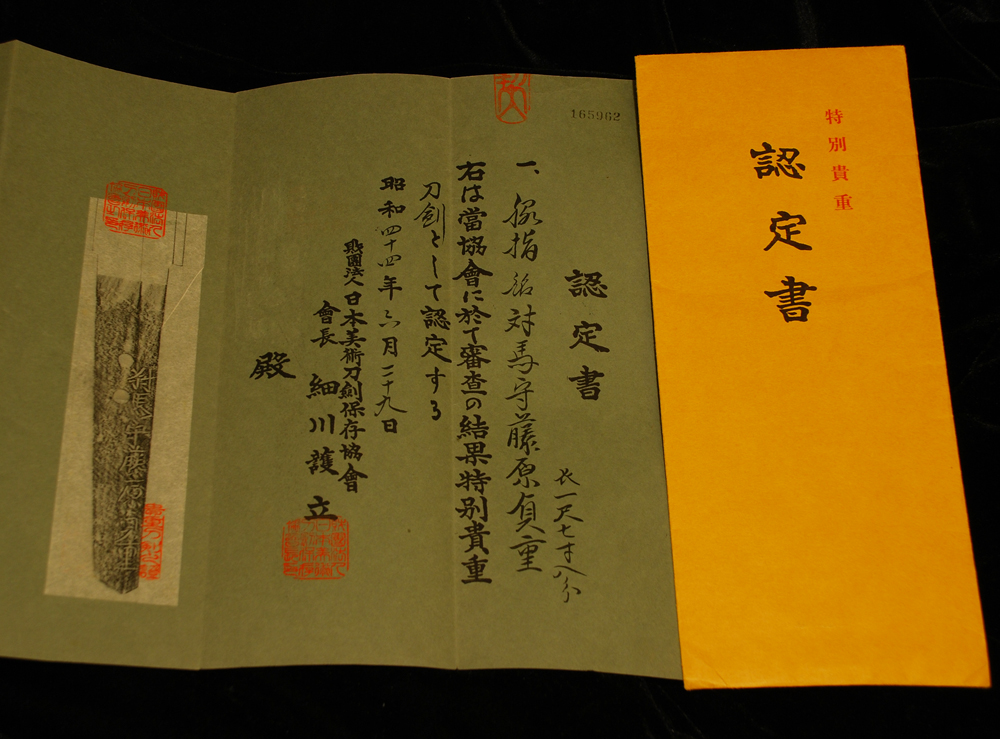Three Outstanding Fighting Wakizashi of the Shinto Period
This an overview of three wakizashi that we recently were privileged to study. They are not directly related to each other. The common bond is that they are all "good cutters" and from about the same time period Circa Kanbun 1661 1673 One is a "O wazamono" Owari maker. Another is a "Ryo wazamono" Aizu maker who's son was a "Saijo O Wazamono" maker and another is a Bungo blade with an authenticated Yamao Hisahide 2 body cutting test inlaid on the nakago. A fun topic of study is : What do these blades have in common in their workmanship?
Houshu Takada ju Fujiwara Saneyuki with Two Body Cutting test by Yamano Hisahide
Blade dated 1661
Cutting test done on December 16th 1668
Mei "Houshu Takada ju Fujiwara Saneyuki Kanbun Gannen Hachi gatsu hi"
Cutting test mei: "Kanbun Hachi-nen Dec. 16th Nidou Kiriochi Yamano Kanjuro Hisahide hakikan"
There were two generations of Saneyuki, father and son, active from 1615 - 1672. They made blades of ko-itame with jinie, ko-nie covered suguha or gunome with choji, the boshi are sugu with komaru tip. Tokotaikan rating: 2.5 million Yen for the father and 2 million Yen for the son. The cutting test was done by the famous Yamano Kanjuro Hisahide. Hisahide and his father, Yamano KaEmon Nagahisa, were said to be personally responsible for the fame of Kotetsu Okisato.

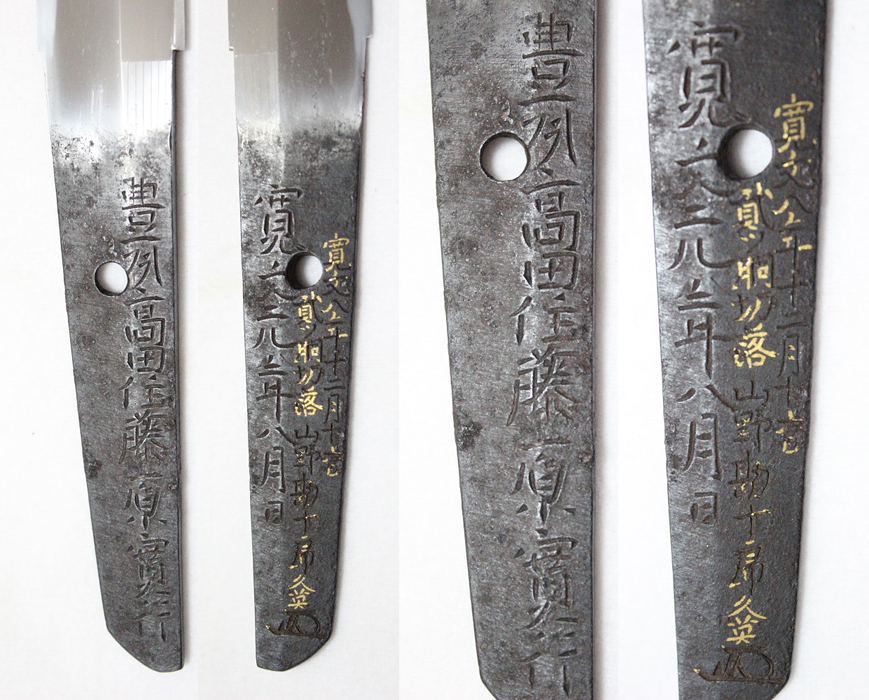
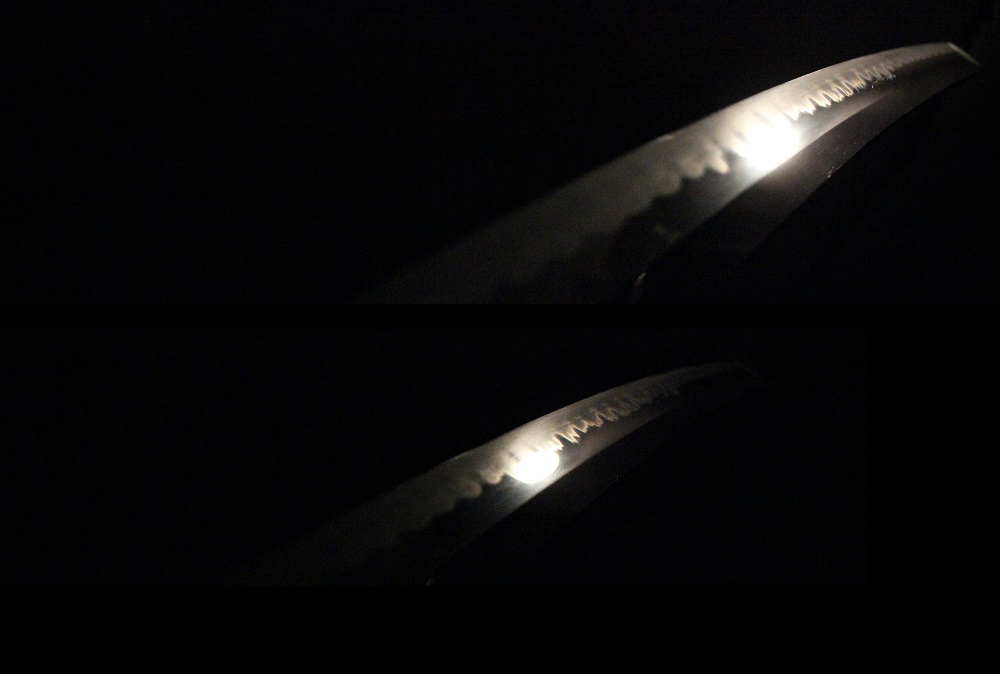
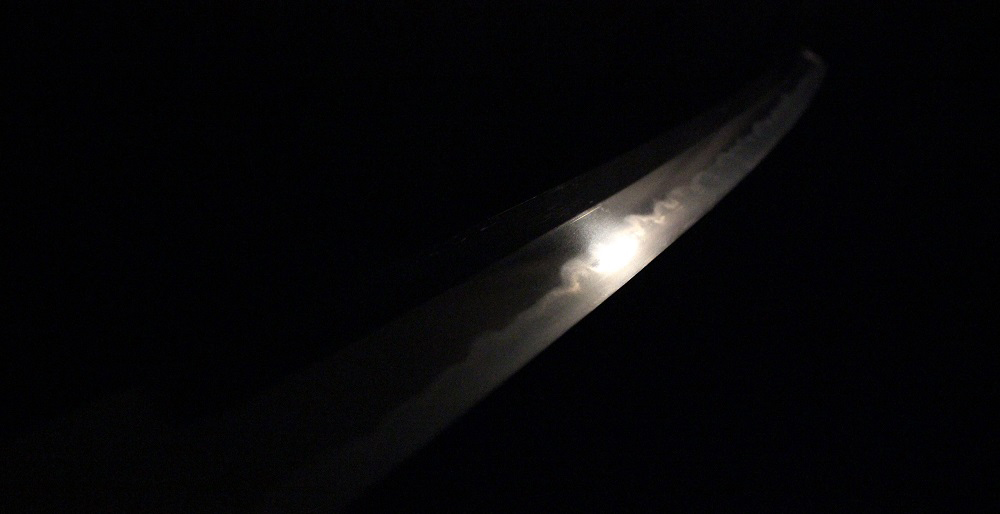
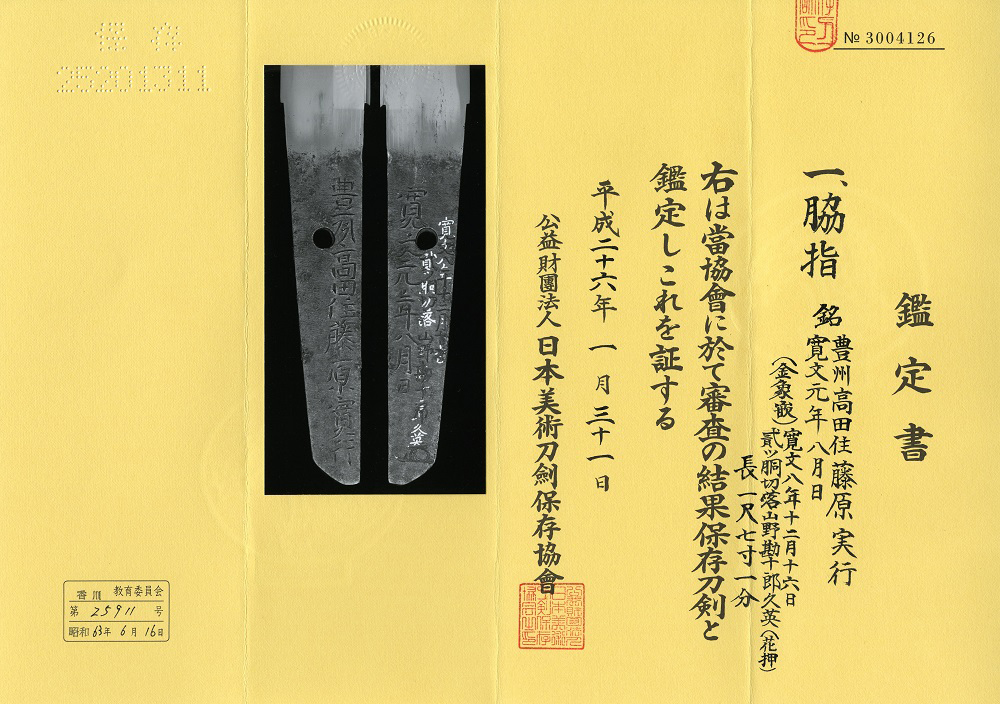
Oushu Aizu ju Masanaga
The
example blade shown is by Miyoshi Masanaga, 三好政長 (The second smith listed in this section) Here is a brief history of the Miyoshi family:
Miyoshi Nagakuni, 三好長国
Nagakuni was born in
Hiroshima in 1577. He learned sword-making from his father. His early mei was Yasuhiro 安広. After his father died, he went to live
with his uncle, Horima no Kami
Teruhiro 輝広 and continued to learn sword-making from him.
Nagakuni later became retainer smith of the Katou 加藤 family and moved to
Iyo Matsuyama. In the year of Kanei 4th, 1627, Katou
family’s territory became Aizu. Therefore, Nagakuni took his family and moved with his lord. He died four years after the move at age 54 on 6/18/1631. Nagakuni is rated at
4 million yen in the Tokotaikan.
Miyoshi Masanaga, 三好政長 (the example blade shown)
He
is the son of Miyoshi Nagakuni. He was born in Iyo Matsuyama and moved to Aizu with his father. He went to Kyoto and learned sword-making and horimono skills from Umetada Myoju. Other Umetada Myoju students are Hizen Tadayoshi, Munenaga, Yoshinobu and Geishu Teruhiro. His early mei was 正長. Because this Masa character 正 was used by Hoshina Masayuki, he changed his “masa”
to 政.
(same pronouncation but different kanji) Hoshina Masayuki took over the Katou
Family as the ruler of Aizu in 1643. He established the Matsudaira
Family who ruled Aizu until the end of the Tokugawa shogunate. Miyoshi Masanaga died at age 50 on 1/3/1648.
The
jigane of Masanaga’s blades
are mainly itame that stands-up similar to that of
the Horikawa school. Hamon is suguha with ko-midare and shallow gunome with
ko-nie. The Tokotaikan rates his blades at 3.5 million Yen. He is also one of 59 smiths with the rank of Ryo-wazamono for the cutting ability of his works.
3. Miyoshi Nagamichi,
He
was the son of Miyoshi Masanaga. He was born in Aizu,
1633. His early mei was 三好道長. He learned sword-making from his father and
later his uncle, Nagatoshi 長俊. He received the title of Mutsu
no Daimyo in 1659 at age 27. It is believed that he changed his last name from
Miyoshi 三好 to Miyoshi 三善 around or before this time.
Kataoka Ginsaku stated that Miyoshi Nagamichi took a blade he made and went to Edo to see Yamano Kanjuro Hisahide ( Hisahide is the same tester that did the two body cutting
test on the Saneyuki shown on in this article) Nagamichi’s blade
was was able to cut three bodys
in half with one stoke. Hisahide was very impressed and taught Nagamichi
the secrets of improving this cutting ability even more . Nagamishi
made katana and wakizashi but no tanto
exist by him. His jigane
styles are ko-itame with jinie
and running itame with hada-tachi.
Hamon styles are gunome, notare, and suguha with ko-nie covered deep and bright nioi-guchi.
There are kinsuji
and sunagashi in the hamon.
His best blades are similar to that of
the Kotetsu and he was known as Aizu
Kotetsu. He died at age 53 in 11/17/1685. Tokotaikan rated his blades as 6 million Yen and he is one
of the 11 Saijo O-wazamono
smiths.
The
example blade shown is by Miyoshi Masanaga, 三好政長 (The second smith listed in this section) Here is a brief history of the Miyoshi family:
Miyoshi Nagakuni, 三好長国
Nagakuni was born in
Hiroshima in 1577. He learned sword-making from his father. His early mei was Yasuhiro 安広. After his father died, he went to live
with his uncle, Horima no Kami
Teruhiro 輝広 and continued to learn sword-making from him.
Nagakuni later became retainer smith of the Katou 加藤 family and moved to
Iyo Matsuyama. In the year of Kanei 4th, 1627, Katou
family’s territory became Aizu. Therefore, Nagakuni took his family and moved with his lord. He died four years after the move at age 54 on 6/18/1631. Nagakuni is rated at
4 million yen in the Tokotaikan.
Miyoshi Masanaga, 三好政長 (the example blade shown)
He
is the son of Miyoshi Nagakuni. He was born in Iyo Matsuyama and moved to Aizu with his father. He went to Kyoto and learned sword-making and horimono skills from Umetada Myoju. Other Umetada Myoju students are Hizen Tadayoshi, Munenaga, Yoshinobu and Geishu Teruhiro. His early mei was 正長. Because this Masa character 正 was used by Hoshina Masayuki, he changed his “masa”
to 政.
(same pronouncation but different kanji) Hoshina Masayuki took over the Katou
Family as the ruler of Aizu in 1643. He established the Matsudaira
Family who ruled Aizu until the end of the Tokugawa shogunate. Miyoshi Masanaga died at age 50 on 1/3/1648.
The
jigane of Masanaga’s blades
are mainly itame that stands-up similar to that of
the Horikawa school. Hamon is suguha with ko-midare and shallow gunome with
ko-nie. The Tokotaikan rates his blades at 3.5 million Yen. He is also one of 59 smiths with the rank of Ryo-wazamono for the cutting ability of his works.
3. Miyoshi Nagamichi,
He
was the son of Miyoshi Masanaga. He was born in Aizu,
1633. His early mei was 三好道長. He learned sword-making from his father and
later his uncle, Nagatoshi 長俊. He received the title of Mutsu
no Daimyo in 1659 at age 27. It is believed that he changed his last name from
Miyoshi 三好 to Miyoshi 三善 around or before this time.
Kataoka Ginsaku stated that Miyoshi Nagamichi took a blade he made and went to Edo to see Yamano Kanjuro Hisahide ( Hisahide is the same tester that did the two body cutting
test on the Saneyuki shown on in this article) Nagamichi’s blade
was was able to cut three bodys
in half with one stoke. Hisahide was very impressed and taught Nagamichi
the secrets of improving this cutting ability even more . Nagamishi
made katana and wakizashi but no tanto
exist by him. His jigane
styles are ko-itame with jinie
and running itame with hada-tachi.
Hamon styles are gunome, notare, and suguha with ko-nie covered deep and bright nioi-guchi.
There are kinsuji
and sunagashi in the hamon.
His best blades are similar to that of
the Kotetsu and he was known as Aizu
Kotetsu. He died at age 53 in 11/17/1685. Tokotaikan rated his blades as 6 million Yen and he is one
of the 11 Saijo O-wazamono
smiths.

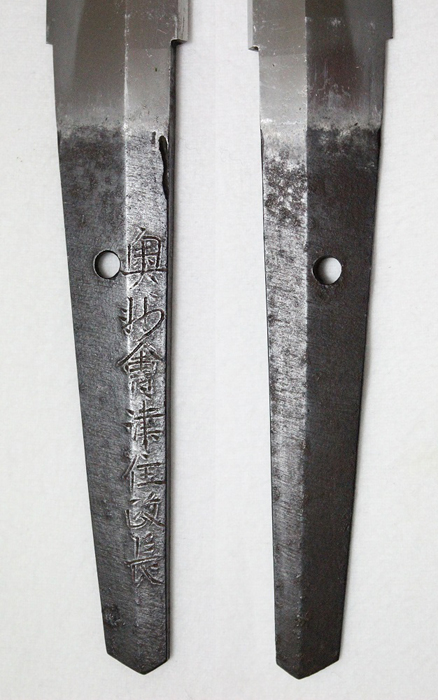
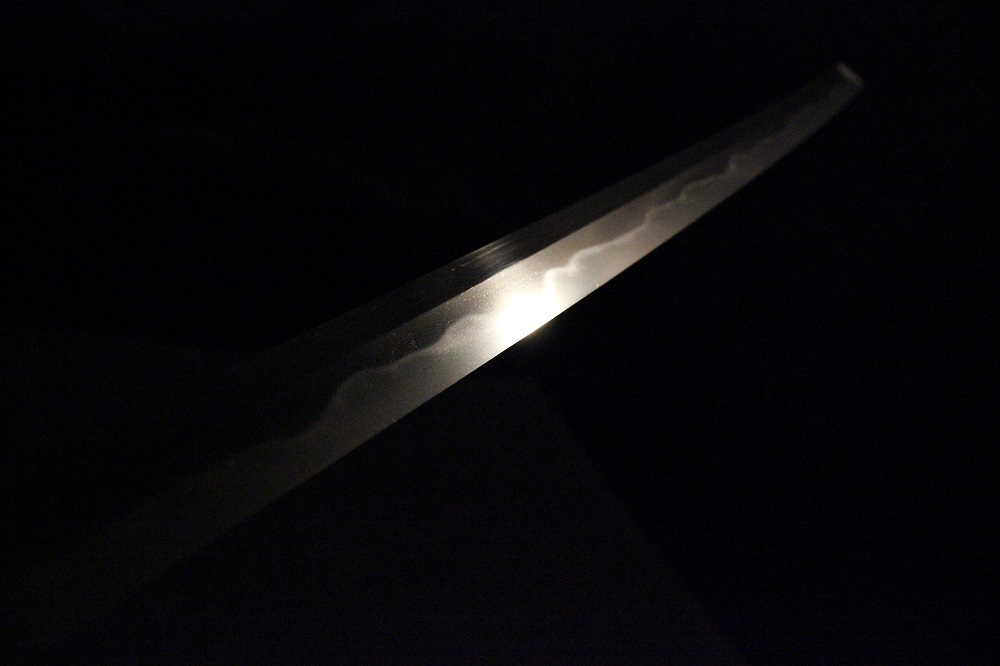
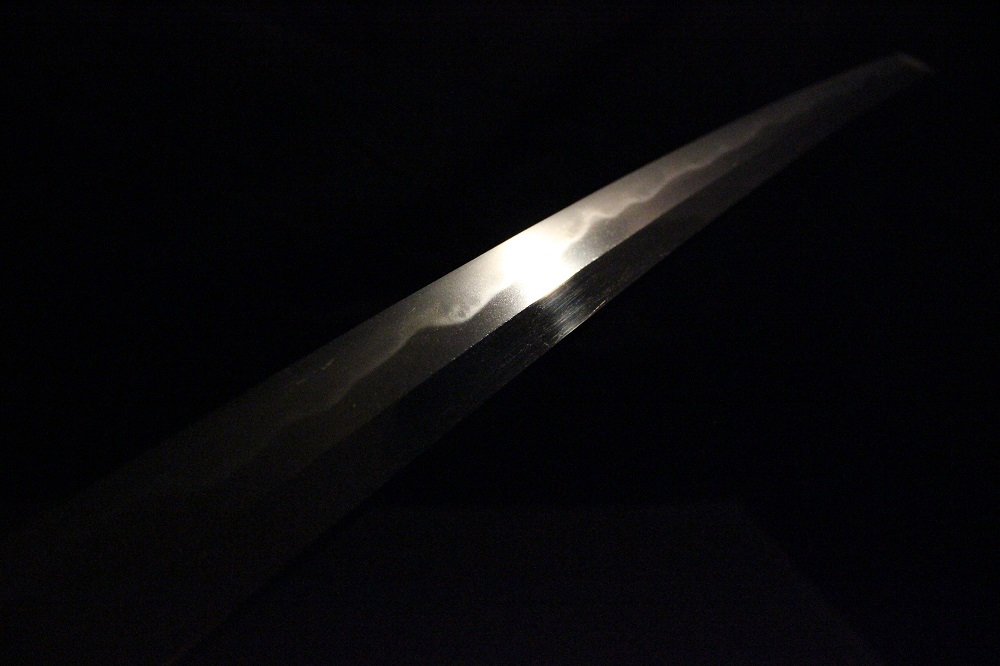
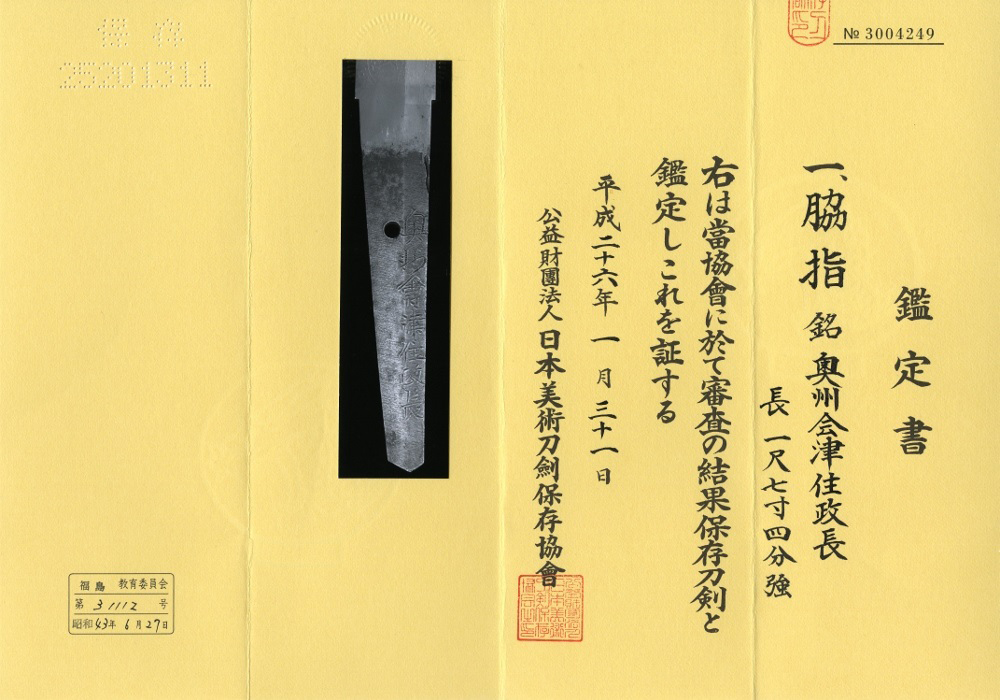
Tsushima no Kami Fujiwara Sadashige
Also signed Bishu Tshushima no Kami Fujiwara Sadashige, A student of Etchu no Kami Fujiwara Sadayuki, He was an Owari smith and active around the Kanbun era (circa 1661) He also made blades in Nagoya and Osaka. He hamon styles are in Gunome and Notare. He is one of 21 smiths ranked at O-wazamono by Yamada Asaemon for the cutting ability of his swords. Sadashiges's Tokotaikan rating is 2 million Yen.



